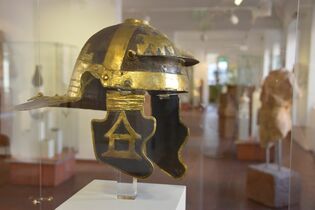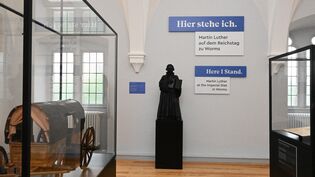
The collection
The permanent collection boasts an impressive variety of exhibits. It features archaeological finds from the New Stone Age (Neolithic Age), reminders of the occasion when the reformer Dr Martin Luther was summoned to appear in Worms, and also one of the largest collections of Roman glassware in Germany.
Read more about the impressive variety of exhibits in our permanent collection here, or better yet, come and see for yourself!
Neolithic, Bronze Age and Iron Age
The beginning of the human sedentary lifestyle in Rheinhessen was accompanied by a series of profound technical and social changes that mark the onset of the Neolithic period. The museum's exhibition showcases numerous objects from this period, ranging from ceramics from the Linear Pottery culture to grinding stones for bread, jewellery and tools. An axe made of Alpine jade found near Westhofen was probably used primarily for aesthetic purposes.
Worms is of particular importance for its artefacts from the early Bronze Age, which can be attributed to the so-called "Adlerberg culture", named after the Adlerberg hill in the south of Worms, where important finds were made towards the end of the 19th century. Another special "highlight" is the enigmatic artefacts from the late Bronze Age, which some researchers refer to as "moon idols" due to their similarity to the crescent moon. Some have interpreted them as ritual objects or roof ridge decorations, while others see them as profane andirons for the fireplace.
Three human skeletons from graves of different eras and the skeleton of a horse from Abenheim, which was cut into large pieces and buried during the Hallstatt period, provide insights into the life and death of humans and animals in earlier times. The increasing trade contacts between the inhabitants of Rheinhessen and Italy at the transition between the Hallstatt and La Tène periods are evidenced by the Etruscan beaked jugs, produced in what is now Tuscany. Along with them, jewellery made of gold, bronze, and iron was found in richly decorated graves from the 5th century BC in Worms-Herrnsheim, testifying to the wealth of the owners and a rich burial culture at that time.
Roman Worms
The exhibits in the Roman section of the museum are particularly impressive. Following the Battle of the Teutoburg Forest (in the year 9 AD), the Rhine marked the boundary of the Roman Empire, and Worms became the site of a Roman fort. Romanized Celts, mainly from Gaul, settled in Rhenish Hesse, and from around 80 AD, the little town called Borbetomagus developed as the most important place in the Citivas Vangionum. There was a forum (under the present cathedral) and a temple, and a grid street plan was created.
Finds from this time can be admired in the museum, for example, consecration inscriptions, altars, and tombstones, but also articles of everyday use.
As well as tableware produced in pottery workshops and intended for local use, you can see examples of terra sigillata and face jugs from Worms (“Wormser Gesichtskrüge“).
Archaeological digs have also unearthed magnificent examples of glassware and a large number of other finds for the museum.
The migration of the Germanic peoples
The prosperity of the Roman period ended with the Migration Period. Only a few objects have been found from the period after 450 AD. Although there is evidence of Germanic immigrants in the late 3rd and early 4th century with neck rings and combs, early Christian gravestones with Latin text and Germanic names only attest to a new population from the middle of the 5th century.
A Burgundian kingdom in Worms in the first half of the 5th century, which is difficult to pin down historically, has been passed down in legend form. Despite the destruction of this kingdom by the Romans, the Roman military presence on the Rhine disappeared soon afterwards.
From the Middle Ages to the present day
You can explore the city's history since the early Middle Ages on the 2nd floor of our museum. Worms, which was apparently only sparsely populated, and the area that is now Rheinhessen were settled by the Franks around 500 AD. Frankish women wore necklaces and heavy gold disc brooches as jewellery at their burial. Men were often buried with weapons, such as the magnificent spatha with a gold handle set with almandines. Glass beakers have now been restored and found their way into the museum as grave goods.
The other exhibits bear witness to the turbulent history of Worms in the following centuries between bishop, city council, and emperor. They illustrate the warlike events such as feuds, the Peasants' War, and the great destruction of the city in 1689, the flourishing trades, and the handling of crime and punishment in the Middle Ages and early modern times. A 3D film reconstruction and individual architectural fragments show the former splendor of St. John's Church, the Romanesque baptistery of the cathedral, which was demolished in the 19th century.
“Here I stand!"
“Here I stand!" is the motto of the new exhibition cabinet set up in 2023, which is dedicated to the courageous appearance of the reformer Martin Luther at the Diet of Worms in 1521.
With his publicly declared refusal to retract his provocative writings and theological convictions before the emperor and the empire, the professor from Wittenberg risked life and limb and the destruction of his publications on the 17th and 18th of April 1521, having already been excommunicated from the church. How this trial of strength came about, which actors and interests were at work behind the scenes of the political stage, what happened (and what didn't) in the Worms bishop's court, and how ‘Brother Martin’ disappeared from the scene after the Diet of Worms through a secret mission, only to appear incognito shortly afterward as ‘Junker Jörg’ at Wartburg Castle near Eisenach with his groundbreaking translation of the Bible – this and much more can be seen in concentrated form in the section "Here I stand! – Luther in Worms": especially, but not only, for declared admirers of the important but therefore also polarizing reformer."
Cloister
The Romanesque cloister, enclosing a picturesque courtyard on all four sides, comprises an older section housing the lapidarium, a collection of ancient stone artefacts, and a newer section displaying exhibits on the history of the city and the museum.
Worms City History and Museum History
The two cloister wings on the north and east sides present the history of Worms through selected exhibits and film reconstructions of the cityscape at different times. The city model, depicting Worms before the great destruction of 1689 and crafted by model maker Christian Häussler, offers a unique visualisation. It was based on drawings by Peter Hamman, who recreated the streets of his hometown from memory after the destruction. This part of the exhibition also details the history of the museum since its foundation in 1881 and of the Andreasstift (St Andrew's collegiate church) as a complex of buildings from the late Romanesque period.
Lapidarium
On the south and west sides of the cloister are noteworthy stone artefacts that also provide insight into the turbulent history of Worms. The oldest pieces date back to Roman times and primarily consist of gravestones belonging to cavalry soldiers, often depicted as courageous fighters using their horses and lances to strike down helpless barbarians. There are also a few stones from civilian graves, such as the joint gravestone of brothers Severius Lupulus and Severius Florentinus and the sarcophagus of Spectatia Spectata. Both express the profound grief of the bereaved over the death of their family members through their inscriptions. Roman milestones and consecration stones are also on display here.
From the Middle Ages and early modern period, there are numerous gravestones of people buried in and around Worms many from the city's numerous collegiate churches and monasteries. Particularly notable are the sandstone slabs attached to the former Haus zur Münze, known as the "most beautiful house in the world", as the people of Worms proudly called their town hall. These slabs depict three important emperors of the Holy Roman Empire during the transition to the early modern period, adorned with crown, sword, and with orb and cross, emphasising the citizens of Worms’ claim to prestige during this time.
St Andrew's collegiate church
The tour ends with a visit to the former collegiate church. The Romanesque building with Gothic elements is a popular venue for events such as lectures and concerts. It is currently used as a special exhibition space.
Contact
The city museum in the Andreasstift
Weckerlingplatz 7
67547 Worms
Telephone number: +49 (0) 62 41) 8 53 – 41 05
email: msmwrmsd














